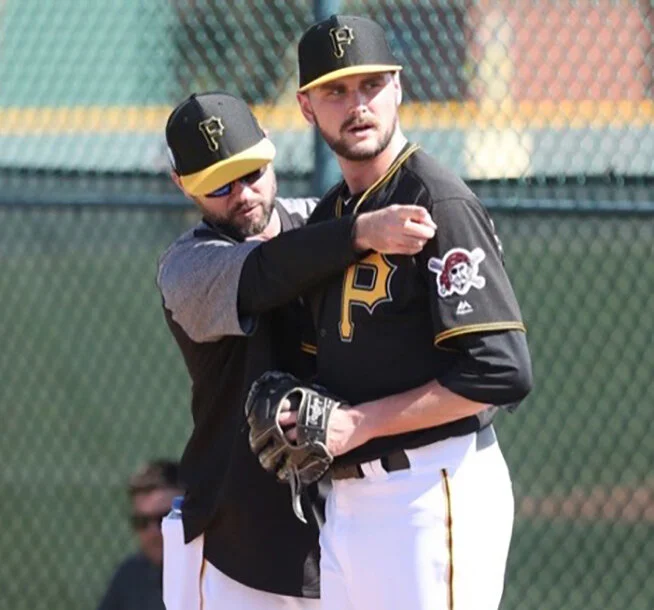This Pro Pitching Coach Slayed the Skeptic Monster
Scott Mitchell tells the story of using new technology to bridge the communications gap with his players
How many times have you heard that saying “You can’t teach an old dog new tricks?” Well, I am here to tell a story that debunks that saying.
People that know me would probably agree that I am skeptically open-minded; It is in my DNA to doubt. I have learned over the years to trust my first gut instinct and it has served me well. I have also learned over the years to seek out information and to ask questions before casting final judgment.

I tried the pitchLogic baseball for the first time in mid-summer. I received an email from our GM, Neal Huntington, asking me if I was interested in trying out a new product. He briefly described it as a baseball that measures spin rate and velocity. I was immediately intrigued because what was being thrown, was picking up the measurements. With more than 100 pitchers in camp, coordinating throwing on Rapsodo and Trackman was a logistical challenge and at times felt more like data collection than a meaningful tool to help players get better. I was excited about pitchLogic because it removed these barriers and it felt just like a regular MLB ball.
Set up was simple. I placed the ball on the charger and download the app. So far so good. I sat down with our pitching coach at Greensboro, Stan Kyles, and showed him the app. The first thing we noticed was the simplicity of the data screen. Easy to read and navigate. So far, that skeptically open-minded monster was kept in check. We asked one of our starters, who was scheduled to throw a bullpen that day, if he wanted to give pitchLogic a try. He was equally excited to use it. His first comment was “it feels like a normal ball.” We discussed his plan for the bullpen session and how we would use the data from the ball during that session.
We headed outside and our pitcher began to throw. After completing his throwing program, he was eager to throw with the pitchLogic ball. I told him I would get it synced up and he could throw with it. Unfortunately, the ball would not sync with the app. The skeptically open-minded monster was triggered. “Here we go again!” After the bullpen session was finished, I called David Rankin at F5 Sports. I explained to him what had transpired and he walked me through trying to get the ball to sync up. We were unsuccessful.
During the call, I could tell David was not only passionate about the ball but he was also passionate about helping players get better. My gut was telling me that this company’s intentions and beliefs were aligned with my own. I shared with David that I thought the ball could be the key to merging the two worlds of old school coaching and new school data and tech. The pitcher is throwing what is being measured. The data would be presented almost immediately and the simplicity of the app would allow the communication of the data to be tailored to each individual pitcher. David offered to get me a new ball the next day, but I was leaving for Pirate City in the morning. David asked if they could meet me down there. Talk about customer service! I told them absolutely and we set up a time to meet once they arrived.

David arrived arrived in Pirate City with Lary Sorensen a few days later. I invited one of our analysts and our Rehab Coordinator, Matt Ford, to join us. I believed pitchLogic would be a huge asset in rehab throwing, allowing us to monitor consistent release points and proper spin on the ball. It was a very productive meeting. David and Lary walked us through the research and production of the ball. I shared with them my reservations on the accuracy of the data and also the need to be able to coach off of the data. The conversation was awesome. Each side listening to the other and both sides willing to learn from one another.
After about an hour, we took a new pitchLogic ball outside to throw. I handed David my phone and asked him to sync up the ball to avoid “user error.” The ball successfully synced up and we began to capture data. My faith was restored! Throw after throw, the data was recorded and I was eager to get the pitcher on the mound. Once we got over to the bullpen and starting throwing, I was waiting for the other shoe to drop. When would we hit our first snag? We did not hit one. We captured every pitch.
During the session, the plan was to have the pitcher match his curve ball arm slot to his fast ball arm slot. After throwing a few curve balls, I asked the pitcher what he was feeling. He stated he felt like he was getting on the side of the curve ball, throwing more of a slurve. I asked him what could cause that. He asked, “dropping my slot?” I walked over and showed him the clock face display and showed him his last few fast balls. His release was consistently around the 1:00 mark. I then showed him his curve balls and he noticed it was consistently just below 2:00. The data was backing up what he was feeling and what I was seeing. It was kind of like having an impartial moderator at a debate. The pitcher said he was going to think fast ball while throwing his next curve ball. He threw the curve ball and I showed him the app. Release was at 1:00, mirroring his fast ball. I also showed him that the total spin increased, the spin efficiency improved, and the break on the pitch was more 12-6. The pitcher said seeing the clock face helped him connect the dots between what I was asking him to do and what he was feeling.
To say I was elated was an understatement! I put in a large order and sent baseballs to all of our affiliates. We began using them throughout our minor league system. The merging of the two worlds was taking place and we began to coach with the data. This old dog had learned a new trick. The data was the piece of the puzzle that allowed us to communicate with the pitchers individually, and tailor coaching to their needs.

